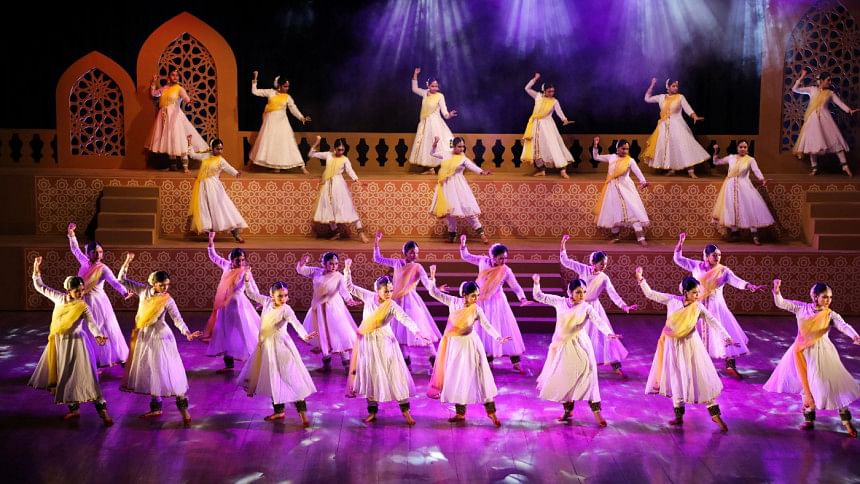‘Kathaknritya Sandhya’: Going back to the roots of classical dance

The auditorium was lit in kaleidoscopic hues, with the majestic stage of the National Theater Hall welcoming viewers to the much-awaited visual treat. The sound of ghungur crept in from time to time, leaving all in anticipation.
On Saturday, Nrityanchal Dance Academy organised "Kathaknritya Sandhya 2023" at Bangladesh Shilpakala Academy.
Tickets were selling out, with almost no seats to spare, and chairs were placed in between to accommodate the keen spectators. "It remains so difficult to book halls for dance programmes these days," lamented renowned actor and director Mamunur Rashid, who was present as a guest at the event.

Yesterday evening was about Kathak, one of the eight forms of classical dancing known for its sophisticated footwork and graceful hand gestures or Mudras. Around 300 dancers graced the stage in perfect synchrony and symphony to the beats of the tabla and flute.
Among the other guests were National-Award-winning Odissi dancer Kajol Ibrahim; choreographer Minu Haque; internationally acclaimed Kathak dancer and choreographer from Kolkata, Modhumita Roy and more. The evening was dedicated to celebrating the 85th birthday of legendary dancer, the late Pandit Birju Maharaj, and in remembrance of esteemed journalist, the late Muhammad Jahangir—who served as a coordinator for Nrityanchal Dance Academy.

Ranging between fast and medium rhythm, artistes took entry on the stage by greeting the audience with a Salami aamad to begin the show. Followed by a Bhajan that reflected on the spiritual connection between a devotee and deity, the tranquillity in the air soon transformed into the charm in 'Protibimbo' where performers on either side mirrored their movements to imitate a mirror. Modhumita Roy herself performed as well, on request, to a thumri, illustrating a banter between Radha and Krishna.

Kathak has been omnipresent in history to narrate stories via dancing. It has been popular since the times of Mughal emperors when Mujra was performed by Nortokis in front of Kings and Queens. However, there is a negative connotation attached to the terms amongst populaces while in reality, Nortoki refers to 'women dancer' and Mujra translates to a respectful salute in Marathi. Bringing forward those dances in a positive light, a segment was dedicated to Kathak performances portrayed in the filmography of various times. Dances were performed to the iconic songs of "Pyar kiya toh darna kya" from "Anarkali" (1953), "Chalte chalte" and "Inhi Logon Ne" from "Pakeezah" (1972), "In Aankhon Ki Masti" from "Umrao Jaan" (1981), "Mohe Rang Do Laal" from "Bajirao Mastani" (2015) and many more.
The performances highlighted the role of nature, love, and the beauty of rhythm evermore in riveting pirouettes or Chakkars and gracefully accelerating Tatkar. Undoubtedly, the highlight of the show was when around 300 students of Nrityanchal Dance Academy took over the stage for the concluding performance of the institution. Alongside, the audience sat mesmerised when two children with disabilities danced gracefully, while all the other dancers cheered them on with rhythm and beats in hand.
"I wish I had a child of such young age so that I too could feel the racing heartbeats of the parents who await to see their young ones perform on stage." said Mamunur Rashid about the proud parents who came to see their children perform.
"Shibli and Nipa have made the impossible possible. For so many years, they have continued and spread the art of Kathak dancing and I am amazed at the wonderfully organised and systematic manner in which they taught and congregated their students to perform here today," said Modhumita Roy, who conducted a 5-day workshop as part of the dance festivities of Nrityanchal Dance Academy from February 19 to 23.

The programme was hosted by Nrityanchal Dance Academy with the assistance of Bangladesh Shilpakala Academy. The dance performances were directed by Shibli Mohammad, under the overall supervision of Shamim Ara Nipa.


 For all latest news, follow The Daily Star's Google News channel.
For all latest news, follow The Daily Star's Google News channel. 



Comments